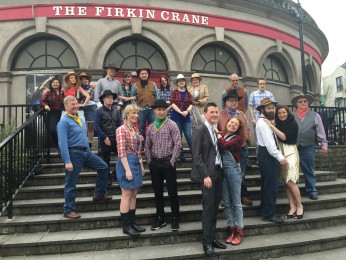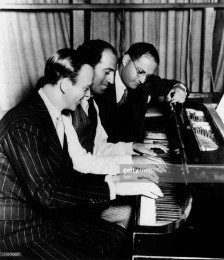Kieran’s Our City, Our Town Article,
Cork Independent, 21 April 2016
Crazy for You
My second foray with Cork City Musical Society brings Crazy for You the musical from 29 April to 1 May in the Firkin Crane Shandon, four performances (three evening shows and a matinee). The show for all the family is being directed by myself, has a cast of 30 and a 7-piece band, with musical direction by Michael Young and choreography by Aisling Byrne Gaughan.
We are delighted to present our musical to the public. Our cast of 30 have worked very hard on this production to bring a toe-tapping, sing-along and funny musical, which will leave a smile on the faces of the audience. Amateur musical societies are multiple in nature up and down the country. All bring their local communities together under a volunteer and charity umbrella – collaborating and bringing people together to create an outlet for people and to put drama, music and all ultimately form a key cultural vein within towns and villages. It is important that a city such as Cork has a musical society to promote the inherent love for musical theatre.
Crazy for You is a romantic love musical with lyrics by Ira Gershwin, and music by George Gershwin. Billed as “The New Gershwin Musical Comedy”, it is largely based on the song writing team’s 1930 musical, Girl Crazy, but incorporates songs from several other productions as well. George and Ira Gershwin will always be remembered as the songwriting team whose voice was synonymous with the sounds and style of the Jazz Age. By the time of their 1924 Broadway hit, Lady Be Good!, George had worked with lyricist Buddy DeSylva on a series of revues, George White’s Scandals, while Ira reveled in success with composer Vincent Youmans on Two Little Girls in Blue. But from 1924 until George’s death in 1937, the brothers wrote almost exclusively with each other, composing over two dozen scores for Broadway and Hollywood. Though they had many individual song hits, their greatest achievement may have been the elevation of musical comedy to an American art form.
The history of jazz has its roots firmly planted in the American cities of New Orleans, Chicago, and New York City. And the musical tradition within these cities still lives on today. As jazz spread around the world, it drew on different national, regional, and local musical cultures, which gave rise to many distinctive styles. New Orleans jazz began in the early 1910s, combining earlier brass-band marches, French quadrilles, ragtime and blues with collective polyphonic improvisation. In the 1930s, heavily arranged dance-oriented swing big bands, Kansas City jazz, a hard-swinging, bluesy, improvisational style and Gypsy jazz (a style that emphasized musette waltzes) were the prominent styles. Ira Gershwin was a joyous listener to the sounds of the modern world. He had a sharp eye and ear for the minutiae of living. He noted in a diary: “Heard in a day: An elevator’s purr, telephone’s ring, telephone’s buzz, a baby’s moans, a shout of delight, a screech from a ‘flat wheel’, hoarse honks, a hoarse voice, a tinkle, a match scratch on sandpaper, a deep resounding boom of dynamiting in the impending subway, iron hooks on the gutter”.
In studying the history of jazz music on the other side of the Atlantic, it is very interesting to research the anti-jazz movement in Ireland in the 1930s. It is difficult to imagine the halting of such glorious toe-tapping music such as “I Got Rhythm”. In an article in the History Ireland magazine (1993) by Jim Smyth entitled Dancing, Depravity and all that Jazz, The Public Dance Halls Act of 1935 he notes the pressure for constraints on the dance halls was becoming forceful. The Gaelic League re-launched its anti-jazz campaign in 1934 with a statement very much in tune with the sentiments of the bishops: “It is this music and verse that the Gaelic League is determined to crush…its influence is denationalising in that its references are to things foreign to Irishmen: that it is the present day instrument of social degradations all too plain, even in Ireland. That was the reason for their-launching of the anti-jazz campaign, the reason it received the blessing of the church and the approval of the state. The League was quick to condemn politicians who were seen as behavin an ‘anti-national’ fashion”. The Secretary of the League, attacking the broadcasting of jazz on Radio Éireann, had this to say about the minister responsible: “Our Minister of Finance has a soul buried in jazz and is selling the musical soul of the nation for the dividends of sponsored jazz programmes. He is jazzing every night of the week”. A number of County Councils adopted resolutions condemning jazz and all-night dancing. In January 1934 a large demonstration took place in Mohill, County Leitrim. It was made up mostly of young people and the press estimated the attendance at 3,000, with five bands and banners inscribed with “Down with Jazz” and “Out with Paganism”. Support came from church and state.
But one can imagine that deep within some dance halls, the needs to release this soulful and spirit enhancing music. Come and enjoy Cork City’s musical production of Crazy for You, 29 April-1 May, see www.firkincrane.ie for tickets.
Captions:
840a. Some of the cast for the upcoming Cork City Musical Society production of Crazy for You, The New Musical; 29 April-1 May, www.firkincrane.ie for tickets (picture: Kieran McCarthy)
840b. George Gershwin at piano with Ira Gershwin and Fred Astaire (source: Getty Images)

